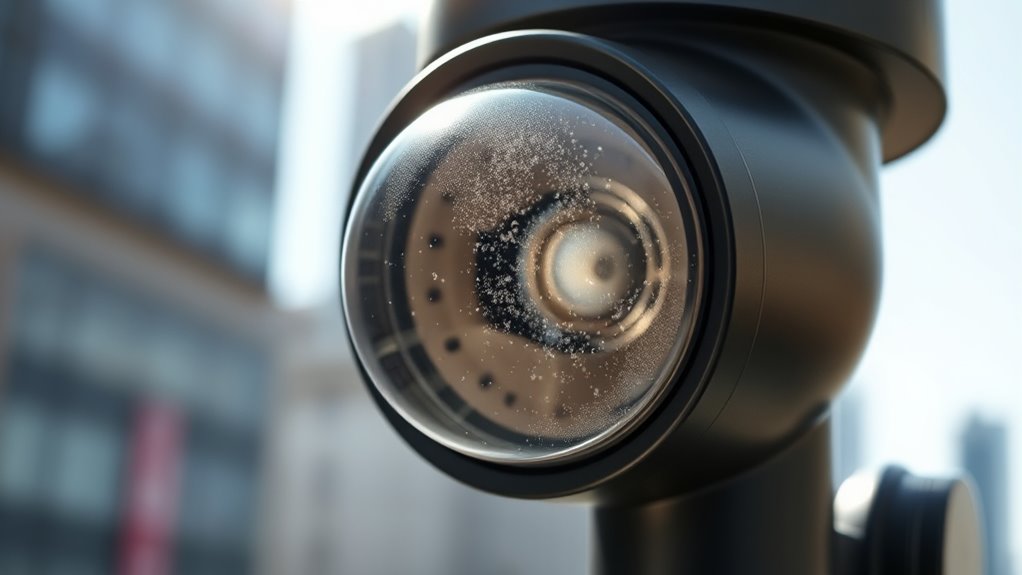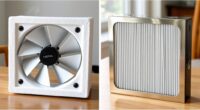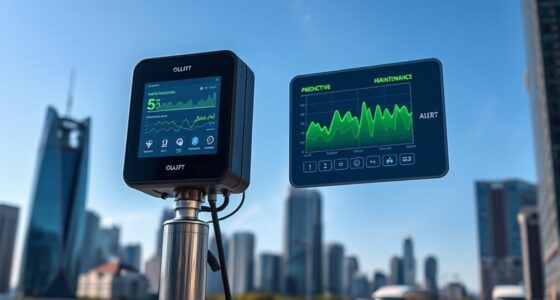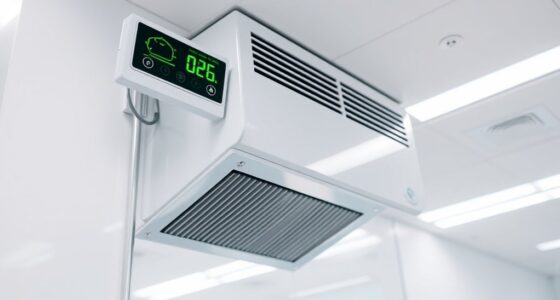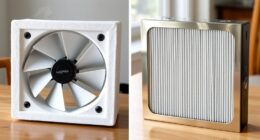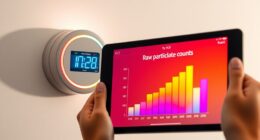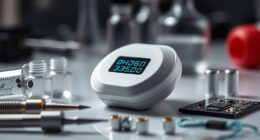To select the right particulate matter sensor, focus on quality, calibration stability, and environmental resilience. Look for sensors with proven performance, advanced detection methods, and features like automated calibration routines. Consider your operating environment—outdoor or indoor—and choose a durable model that can withstand weather or dust. Reputable manufacturers often provide support and guidance to guarantee long-term accuracy. If you keep exploring, you’ll discover how to optimize your sensor setup for reliable air monitoring.
Key Takeaways
- Prioritize sensors with proven calibration stability and automated recalibration features to ensure long-term measurement accuracy.
- Choose sensors utilizing advanced detection methods like laser scattering or beta attenuation for reliable PM readings.
- Ensure sensors are suitable for your environment, with environmental resilience to weather, dust, and humidity.
- Select reputable manufacturers offering strong technical support, clear calibration procedures, and built-in calibration routines.
- Consider sensor durability, maintenance needs, and the ability to cross-reference with reference-grade instruments for data validity.
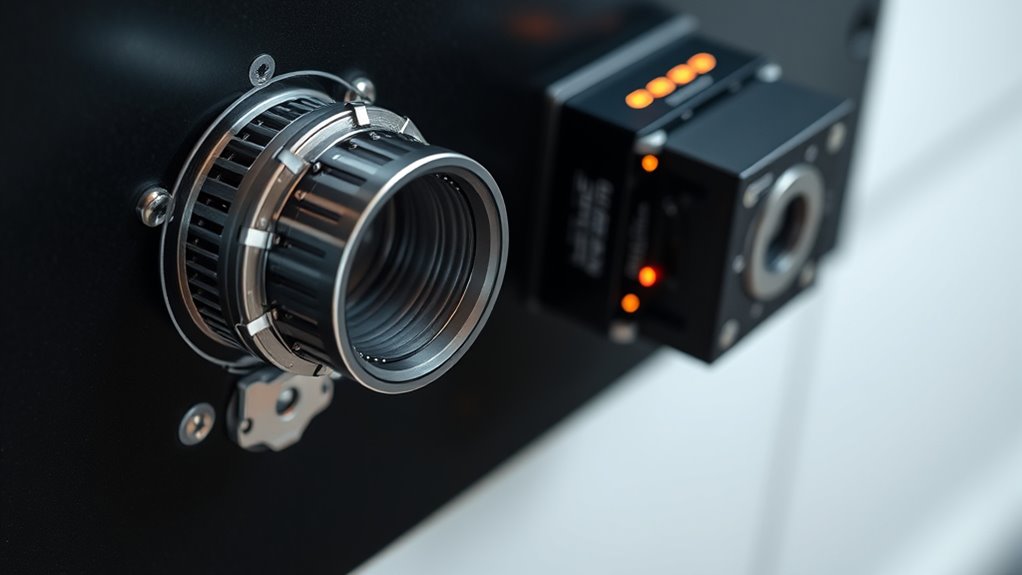
Selecting the right sensor for particulate matter (PM) monitoring is vital to guarantee accurate and reliable air quality data. The foundation of dependable measurements lies in proper sensor calibration, which ensures that your device produces precise readings over time. When a sensor is correctly calibrated, it aligns with standardized reference instruments, minimizing errors and maintaining consistency. This step is essential because even small inaccuracies can lead to flawed conclusions about air pollution levels, affecting public health decisions and regulatory compliance. You need to choose sensors that come with manufacturer-recommended calibration protocols or allow for easy recalibration, so you can keep your data accurate as conditions change or sensors age.
Proper calibration ensures accurate, reliable PM data for long-term air quality monitoring.
Data accuracy hinges heavily on selecting sensors with high-quality components and proven performance. Keep in mind that not all PM sensors are created equal; some may be sensitive to environmental factors like humidity, temperature fluctuations, or interference from other particles. When evaluating sensors, look for ones that are designed with robust filtering systems and advanced detection methods, such as laser scattering or beta attenuation, which are known for their reliability. It’s also wise to consider sensors that offer real-time data validation features or diagnostic alerts, so you can quickly identify and rectify inaccuracies before they compromise your dataset. Guaranteeing data accuracy isn’t a one-time task; it requires ongoing maintenance, regular calibration checks, and sometimes, cross-referencing with reference-grade instruments to validate sensor performance.
Furthermore, selecting sensors with calibration stability and automated recalibration routines can significantly reduce maintenance efforts and enhance long-term accuracy. Another aspect to ponder is the sensor’s ability to operate within your specific environment. For instance, sensors used outdoors in urban areas must withstand weather extremes, while indoor sensors should be resistant to dust and humidity. This environmental resilience impacts both calibration stability and long-term data accuracy. When selecting sensors, review their specifications carefully and seek units with proven durability and proven calibration stability over extended periods. Some sensors also come with built-in calibration features or automated recalibration routines, which can save you time and reduce the likelihood of calibration drift affecting your measurements.
Finally, investing in sensors from reputable manufacturers with solid technical support can make a significant difference. They can guide you through proper calibration procedures and troubleshoot issues promptly, maintaining your data’s integrity. Remember, choosing a sensor isn’t just about initial performance; it’s about ensuring consistent, accurate data throughout its operational life. By prioritizing sensor calibration, environmental resilience, and ongoing maintenance, you can confidently monitor particulate matter and make informed decisions based on trustworthy air quality information.
Frequently Asked Questions
How Do Sensor Calibration Procedures Differ Across Brands?
Sensor calibration procedures vary across brands because each manufacturer uses different algorithms, calibration standards, and reference methods. Some brands require frequent calibration with certified reference materials, while others have automated calibration routines. You should carefully follow each brand’s specific calibration instructions, as improper calibration can lead to inaccurate particulate matter readings. Understanding these differences helps ensure your sensor provides reliable data and maintains long-term accuracy.
What Are the Maintenance Requirements for Long-Term Sensor Accuracy?
To maintain long-term sensor accuracy, you should regularly perform sensor cleaning to prevent dust buildup that can skew readings. Additionally, data validation is essential; compare your sensor data with reference measurements periodically to catch drifts. Keep an eye on calibration and replace filters as needed. These steps guarantee your sensor remains dependable over time, giving you consistent, accurate particulate matter monitoring results.
Can Sensors Differentiate Between Different Types of Particulates?
Did you know that some sensors can identify over 90% of particulate types? Yes, with advanced particle identification, your sensors can differentiate between dust, pollen, soot, and other particulates. They achieve this through data discrimination techniques, analyzing size, shape, and composition. This capability helps refine air quality data, ensuring you get precise readings and better insights into pollution sources.
How Do Environmental Conditions Affect Sensor Performance?
Environmental conditions critically impact sensor performance. Humidity interference can cause readings to be inaccurate by affecting particle detection, leading to over- or underestimations. Temperature sensitivity also plays a role, as fluctuating temperatures can influence sensor electronics and measurement accuracy. To guarantee reliable data, you should select sensors with built-in compensation for humidity and temperature variations, and consider deploying environmental controls in your monitoring setup.
What Is the Typical Lifespan of a Particulate Matter Sensor?
The typical lifespan of a particulate matter sensor ranges from 1 to 5 years, depending on factors like usage, environmental conditions, and maintenance. Longevity factors such as dust accumulation, humidity, and temperature fluctuations can accelerate sensor degradation. To maximize sensor lifespan, you should regularly calibrate and clean it, ensure proper installation, and operate within recommended environmental parameters. Proper upkeep helps you sustain accurate readings over an extended period.
Conclusion
Choosing the right sensor is essential for accurate particulate matter monitoring. Remember, using the correct technology can greatly improve air quality assessments and health outcomes. Did you know that PM sensors can detect particles as small as 0.3 micrometers? That’s about 300 times smaller than the width of a human hair. Selecting the right sensor guarantees you get precise data, helping you make informed decisions to protect yourself and your community from harmful air pollution.
